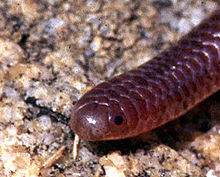The Leptotyphlopidae (commonly called slender blind snakes or thread snakes[2]) are a family of snakes found in North America, South America, Africa and Asia. All are fossorial and adapted to burrowing, feeding on ants and termites. Two subfamilies are recognized.[2]
| Leptotyphlopidae | |
|---|---|

| |
| Western blind snake, Rena humilis | |
| Scientific classification | |
| Domain: | Eukaryota |
| Kingdom: | Animalia |
| Phylum: | Chordata |
| Class: | Reptilia |
| Order: | Squamata |
| Suborder: | Serpentes |
| Infraorder: | Scolecophidia |
| Family: | Leptotyphlopidae Stejneger, 1892 |
| Subfamilies | |
| Synonyms | |
Description edit
Relatively small snakes, leptotyphlopids rarely exceed 30 cm (12 in) in length; only Trilepida macrolepis and Leptotyphlops occidentalis grow larger. The cranium and upper jaws are immobile and no teeth are in the upper jaw. The lower jaw consists of a much elongated quadrate bone, a tiny compound bone, and a relatively larger dentary bone.[3] The body is cylindrical with a blunt head and a short tail. The scales are highly polished. The pheromones they produce protect them from attack by termites.[4] Among these snakes is what is believed to be the world's smallest: L. carlae (Hedges, 2008).[5]
Geographic range edit
Leptotyphlopids are found in Africa, western Asia from Turkey to eastern India, on Socotra Island, and from the southwestern United States south through Mexico and Central America to South America, though not in the high Andes. In Pacific South America, they occur as far south as southern coastal Peru, and on the Atlantic side as far as Uruguay and Argentina. In the Caribbean, they are found on the Bahamas, Hispaniola, and the Lesser Antilles.[1]
Habitat edit
Leptotyphlopids occur in a wide variety of habitats from arid areas to rainforest, and are known to occur near ant and termite nests.
Feeding edit
The diets of leptotyphlopids consist mostly of termite or ant larvae, pupae, and adults. Most species suck out the contents of insect bodies and discard the exoskeleton. [citation needed]
Reproduction edit
Taxonomy edit
- Subfamily Leptotyphlopinae
- Genus Epacrophis Hedges, Adalsteinsson & Branch, 2009 (3 species)
- Genus Leptotyphlops Fitzinger, 1843 (21 species)
- Genus Myriopholis Hedges, Adalsteinsson & Branch, 2009 (23 species)
- Genus Namibiana Hedges, Adalsteinsson & Branch, 2009 (5 species)
- Subfamily Epictinae
- Tribe Epictini, New World snakes
- Subtribe Epictina
Epictia tenella, with coin for scale - Genus Habrophallos Martins, Koch, Pinto, Folly, Fouquet & Passos, 2020 (monotypic, collared blind snake)
- Genus Siagonodon W. Peters, 1881 (4 species)
- Subtribe Renina
- Subtribe Tetracheilostomina
- Genus Mitophis Hedges, Adalsteinsson & Branch, 2009 (4 species)
- Genus Tetracheilostoma Jan, 1861 (3 species)
- Subtribe Epictina
- Tribe Rhinoleptini, African snakes
- Genus Tricheilostoma Jan, 1860 (5 species)
- Genus Rhinoleptus Orejas-Miranda, Roux-Estève & Guibé, 1970 (monotypic, Villiers's blind snake)
- Genus Rhinoguinea J.-F. Trape, 2014 (monotypic, Rhinoguinea magna)
- Tribe Epictini, New World snakes
Gallery edit
-
Leptotyphlops type species; Black thread snake (L. nigricans)
-
Myriopholis type species; Long-tailed thread snake (M. longicauda)
-
Namibiana type species; Western thread snake (N. occidentalis)
-
Habrophallos type species; Collared blind snake (H. collaris)
-
Rena type species; Western blind snake (R. humilis)
-
Trilepida type species; Big-scaled blind snake (T. macrolepis)
See also edit
References edit
- ^ a b McDiarmid RW, Campbell JA, Touré TA (1999). Snake Species of the World: A Taxonomic and Geographic Reference, vol. 1. Washington, District of Columbia: Herpetologists' League. 511 pp. ISBN 1-893777-00-6 (series). ISBN 1-893777-01-4 (volume).
- ^ a b "Leptotyphlopidae". Integrated Taxonomic Information System. Retrieved 18 August 2007.
- ^ a b Leptotyphlopidae at the Reptarium.cz Reptile Database. Accessed 3 November 2008.
- ^ Field Guide to Snakes of Southern Africa - Bill Branch (Struik 1988)
- ^ Hedges SB (2008). "At the lower size limit in snakes: two new species of threadsnakes (Squamata, Leptotyphlopidae, Leptotyphlops) from the Lesser Antilles". Zootaxa 1841: 1-30.PDF at Zootaxa. Accessed 28 July 2008.
External links edit
- "Family Leptotyphlopidae (Slender Blind Snakes)". J. Craig Venter Institute. Archived from the original on 14 June 2009.
- iNaturalist page